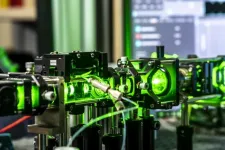(Press-News.org) An international team of researchers may have answered one of space science’s long-running questions – and it could change our understanding of how life began.
Carbon-rich asteroids are abundant in space yet make up less than 5 per cent of meteorites found on Earth.
An international team of scientists from Curtin University’s School of Earth and Planetary Sciences, the International Centre for Radio Astronomy (ICRAR), the Paris Observatory and more scoured the globe to find an answer.
Published today in Nature Astronomy, researchers analysed close to 8500 meteoroids and meteorite impacts, using data from 19 fireball observation networks across 39 countries — making it the most comprehensive study of its kind.
Co-author Dr Hadrien Devillepoix from Curtin’s Space Science and Technology Centre and Curtin Institute of Radio Astronomy (CIRA) said the team discovered Earth’s atmosphere and the Sun act like giant filters, destroying fragile, carbon-rich (carbonaceous) meteoroids before they reach the ground.
“We’ve long suspected weak, carbonaceous material doesn’t survive atmospheric entry,” Dr Devillepoix said.
“What this research shows is many of these meteoroids don’t even make it that far: they break apart from being heated repeatedly as they pass close to the Sun.
“The ones that do survive getting cooked in space are more likely to also make it through Earth’s atmosphere.”
Carbonaceous meteorites are particularly important because they contain water and organic molecules — key ingredients linked to the origin of life on Earth.
Paris Observatory’s Dr Patrick Shober said the findings reshape how scientists interpret meteorites collected so far.
“Carbon-rich meteorites are some of the most chemically primitive materials we can study — they contain water, organic molecules and even amino acids,” Dr Shober said.
“However, we have so few of them in our meteorite collections that we risk having an incomplete picture of what’s actually out there in space and how the building blocks of life arrived on Earth.
“Understanding what gets filtered out and why is key to reconstructing our solar system’s history and the conditions that made life possible.”
The study also found meteoroids created by tidal disruptions — when asteroids break apart from close encounters with planets — are especially fragile and almost never survive atmospheric entry.
“This finding could influence future asteroid missions, impact hazard assessments and even theories on how Earth got its water and organic compounds to allow life to begin,” Dr Shober said.
Other institutions involved in the study were the Astronomical Institute of the Romanian Academy, National Museum of National History and Aix-Marseilles University.
The study was supported by funding from the International Centre for Radio Astronomy Research.
Perihelion history and atmospheric survival as primary drivers of the Earth’s meteorite record was published in Nature Astronomy.
END
Scientists may have solved a puzzling space rock mystery
Carbon-rich asteroids are abundant in space yet make up less than 5 per cent of meteorites found on Earth. An international team of scientists scoured the globe to find an answer
2025-04-14
ELSE PRESS RELEASES FROM THIS DATE:
Sleep matters: Duration, timing, quality and more may affect cardiovascular disease risk
2025-04-14
Statement Highlights:
While the strongest evidence exists that getting sufficient sleep (duration of sleep) is important for overall health , other components of sleep health, such as consistent bedtime, uninterrupted sleep, daytime functioning and self-reported sleep satisfaction, also contribute to cardiometabolic health and related risk factors, including heart disease, stroke, high blood pressure, high cholesterol, inflammation, glucose intolerance, obesity and obstructive sleep apnea.
Differences in sleep health may contribute to increased risk factors and worse health outcomes, particularly for people in under-resourced communities and individuals ...
Light bulb moment for understanding DNA repair switches
2025-04-14
Researchers from the University of Birmingham have uncovered answers that provide the detail to explain two specific DNA repair processes that have long been in question.
The publication of two papers demonstrates how work led by laboratories from the Department of Cancer and Genomic Sciences, and School of Biosciences at the University of Birmingham has made strides in understanding how the repair process is correctly orchestrated.
The importance of understanding DNA repair
Our cells protect their DNA by constantly monitoring and repairing any damage. When DNA is damaged, internal signals activate within the cell to pinpoint the damage and recruit specialised proteins—DNA ...
New method for detecting nanoplastics in body fluids
2025-04-14
Microplastics and the much smaller nanoplastics enter the human body in various ways, for example through food or the air we breathe. A large proportion is excreted, but a certain amount remains in organs, blood and other body fluids. In the FFG bridge project Nano-VISION, which was launched two years ago together with the start-up BRAVE Analytics, a team led by Harald Fitzek from the Institute of Electron Microscopy and Nanoanalysis at Graz University of Technology (TU Graz) and an ophthalmologist from Graz addressed the question of whether nanoplastics also play a role in ophthalmology. The project partners have now been able to develop a method for detecting and quantifying nanoplastics ...
Do disasters delay early cancer diagnoses?
2025-04-14
Rates of colorectal cancer (CRC) diagnoses dropped during and shortly after Hurricanes Irma and Maria and the COVID-19 pandemic in Puerto Rico, according to a recent analysis. However, late-stage diagnoses eventually exceeded expectations, suggesting that limited access to cancer screening services due to these disasters likely hindered timely CRC diagnoses. The findings are published by Wiley online in CANCER, a peer-reviewed journal of the American Cancer Society.
During disasters, medical services may be delayed or inaccessible due to damaged infrastructure, overburdened health ...
Rise and shine: Natural light lessens morning fatigue
2025-04-14
Sleep is a necessary part of people’s daily routine, but modern lifestyles and technology have ushered in an era of decreased rest time and subsequent fatigue. Further, the bedroom environment, such as light, sound, and temperature, is important for a good night's sleep, though this is often neglected in residential architecture.
In search of a conclusive remedy, common sleep studies use artificial light that is easy to control. Osaka Metropolitan University researchers, however, believe natural light could be more effective for re-creating actual living environments.
To test this, Graduate School of Human Life and Ecology student Xiaorui Wang and Professor ...
Nature’s plan for delaying pest resistance deciphered
2025-04-14
Farmers in dozens of countries have embraced crops genetically engineered to produce proteins from Bacillus thuringiensis (Bt) bacteria that kill some key pests yet are safe for people and wildlife. Although this biotech approach reduces reliance on insecticide sprays thereby providing economic and environmental benefits, resistance to Bt crops has evolved in at least 11 species of pests. Thus, effective ways to combat such pest resistance are urgently needed.
A new study published in the Proceedings of the National Academy of Sciences identifies a natural strategy for thwarting pest resistance to Bt proteins. The researchers at the University of Arizona and ...
New guidance for managing obesity in children and adolescents
2025-04-14
A new guideline to help health care providers manage obesity in children and adolescents takes a patient-centred approach, emphasizing behavioural and psychological supports that focus on outcomes valued by patients and their families.
The guidelinehttps://www.cmaj.ca/lookup/doi/10.1503/cmaj.241456, based on the latest evidence, is published in CMAJ (Canadian Medical Association Journal).
It was developed by Obesity Canada through an extensive, 4-year-long collaboration involving adolescents and caregivers with lived obesity experience, methodologists, health care providers, and more than 50 multidisciplinary ...
High blood pressure? Eat more bananas
2025-04-14
New research from the University of Waterloo suggests increasing the ratio of dietary potassium to sodium intake may be more effective for lowering blood pressure than simply reducing sodium intake.
High blood pressure affects over 30 per cent of adults globally. It's the leading cause of coronary heart disease and stroke and may also lead to other afflictions like chronic kidney disease, heart failure, irregular heartbeats, and dementia.
"Usually, when we have high blood pressure, we are advised to eat less salt," said Anita Layton, professor of Applied Mathematics, ...
Weak evidence behind how we measure pain in babies
2025-04-14
A newly-published Cochrane review reveals significant gaps in the clinical rating scales used to assess pain in newborn babies, highlighting the urgent need for improved tools and global collaboration.
Despite the critical importance of accurately measuring pain in newborns, the review found that none of the available scales are backed by the high-quality evidence and methodological safeguards required to confirm their validity and reliability in clinical practice.
Neonatal pain assessment and management presents a challenge for clinical staff worldwide. Over 40 rating scales have been developed and adapted worldwide assessing ...
Novel breath test shows promise for diagnosing and monitoring bacterial infections
2025-04-13
This release has been removed upon request of the submitting institution. Please contact Luke Paskins, luke.paskins@beyondpr.com for more information. END ...
LAST 30 PRESS RELEASES:
Sleeping in on weekends may help boost teens’ mental health
Study: Teens use cellphones for an hour a day at school
After more than two years of war, Palestinian children are hungry, denied education and “like the living dead”
The untold story of life with Prader-Willi syndrome - according to the siblings who live it
How the parasite that ‘gave up sex’ found more hosts – and why its victory won’t last
When is it time to jump? The boiling frog problem of AI use in physics education
Twitter data reveals partisan divide in understanding why pollen season's getting worse
AI is quick but risky for updating old software
Revolutionizing biosecurity: new multi-omics framework to transform invasive species management
From ancient herb to modern medicine: new review unveils the multi-targeted healing potential of Borago officinalis
Building a global scientific community: Biological Diversity Journal announces dual recruitment of Editorial Board and Youth Editorial Board members
Microbes that break down antibiotics help protect ecosystems under drug pollution
Smart biochar that remembers pollutants offers a new way to clean water and recycle biomass
Rice genes matter more than domestication in shaping plant microbiomes
Ticking time bomb: Some farmers report as many as 70 tick encounters over a 6-month period
Turning garden and crop waste into plastics
Scientists discover ‘platypus galaxies’ in the early universe
Seeing thyroid cancer in a new light: when AI meets label-free imaging in the operating room
Neutrophil-to-lymphocyte ratio may aid risk stratification in depressive disorder
2026 Seismological Society of America Annual Meeting
AI-powered ECG analysis offers promising path for early detection of chronic obstructive pulmonary disease, says Mount Sinai researchers
GIMM uncovers flaws in lab-grown heart cells and paves the way for improved treatments
Cracking the evolutionary code of sleep
Medications could help the aging brain cope with surgery, memory impairment
Back pain linked to worse sleep years later in men over 65, according to study
CDC urges ‘shared decision-making’ on some childhood vaccines; many unclear about what that means
New research finds that an ‘equal treatment’ approach to economic opportunity advertising can backfire
Researchers create shape-shifting, self-navigating microparticles
Science army mobilizes to map US soil microbiome
Researchers develop new tools to turn grain crops into biosensors
[Press-News.org] Scientists may have solved a puzzling space rock mysteryCarbon-rich asteroids are abundant in space yet make up less than 5 per cent of meteorites found on Earth. An international team of scientists scoured the globe to find an answer

